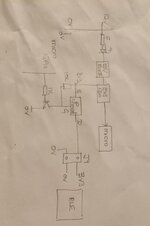Rajinder1268
Full Member level 3
Hi all,
I have an application that requires 3V3 and 5V supply.
I have two PCB's and need to switch the 3V3 to the second PCB via a connector.
What is the best way of doing this please?
I have considered using opto MOSFET (relay), PNP transistor or p channel FET that is driven from a GPIO via a npn transistor - the p channel fet source is tied to 3V3. The gate tied to the source pin via 10K resistor i.e. keeping the p channel off. The gate is also tied to the collector of the NPN, so when this is switched on the p-channel gate is low and the device is switched. I am looking to switch 3V3 @ 500mA. I need the 3V3 to power a silicon labs BLE module.
Thanks in advance.
I have an application that requires 3V3 and 5V supply.
I have two PCB's and need to switch the 3V3 to the second PCB via a connector.
What is the best way of doing this please?
I have considered using opto MOSFET (relay), PNP transistor or p channel FET that is driven from a GPIO via a npn transistor - the p channel fet source is tied to 3V3. The gate tied to the source pin via 10K resistor i.e. keeping the p channel off. The gate is also tied to the collector of the NPN, so when this is switched on the p-channel gate is low and the device is switched. I am looking to switch 3V3 @ 500mA. I need the 3V3 to power a silicon labs BLE module.
Thanks in advance.
